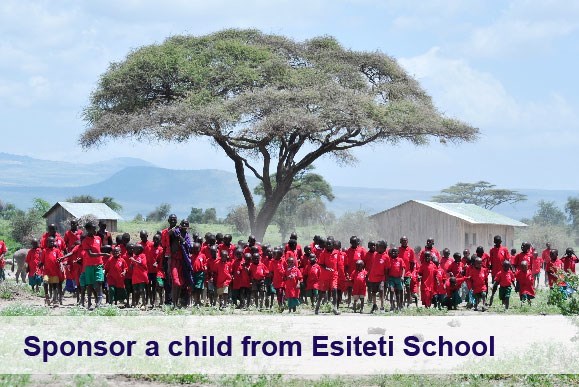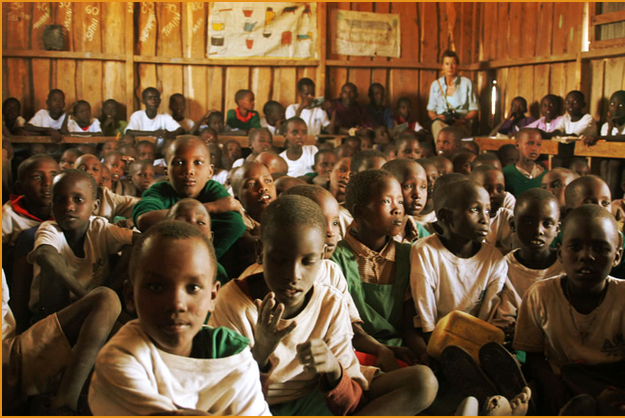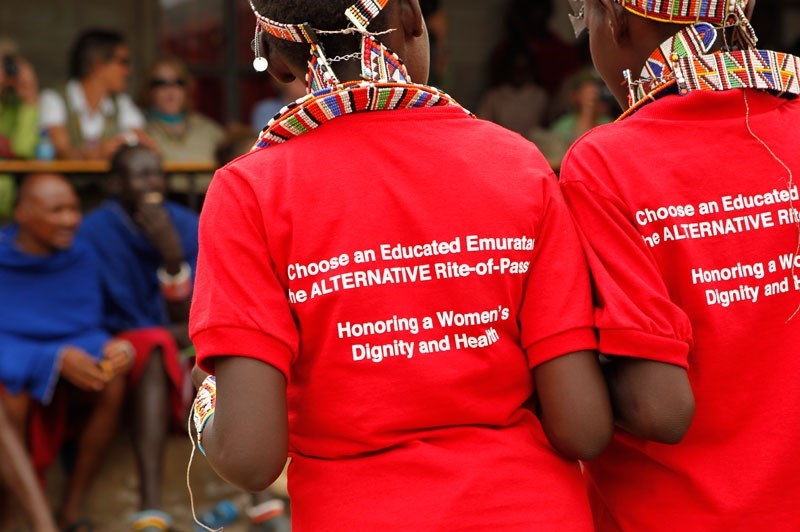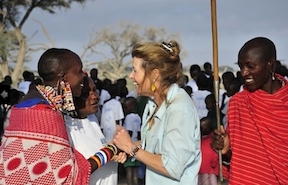 |
| Teri Gabrielsen (askenya.org (askenya.org)) |
Teri Gabrielsen knew from an early age that she wanted to help the needy of the world. When she was 44 her mother in law shared her love for Africa with her family by taking them on Safari to Kenya in Africa. It changed her life forever when the young Maasai warrior spotting animals in their caravan asked if she would like to see the school he was starting. She told an interviewer, "When we arrived, he was with 5 children under a tree writing the alphabet in the dirt. I was hooked."
Not only did Teri go back to Kenya but she founded a non-profit organization called "Africa Schools of Kenya" or ASK to bring education to the village of the young Maasai warrior she had met named James Ole Kamete. 15 years ago James founded the Esiteti Primary and has been instrumental in promoting education for children ages 4 - 18 in his village of 800 Maasai in the Kitirua area of southern Kenya at the border of Tanzania and Kenya.
In a recent film, Maasai At The Crossroads, she said "The moment I set foot here" she thought, "when I can I want to come back and I want to do something. In the film trailer transformation is spoken about a lot. Transformation through education. Transformation through learning about how to plant and sustain trees while learning about the broader world that was previously closed to them. And a critical thing that Teri has accomplished is to give the young girls of this village an Alternative Right of Passage: eliminating the normal, centuries old cutting ritual.
 |
| Maasai Students of Esiteti School (askenya.org ()) |
So who are the MAASAI and what is their culture all about? According to Teri's website askenya.org:
"Occupying the fertile grassland of the Rift valley and surrounding uplands, the pastoral and nomadic Maasai are probably the most renowned Kenyan tribe. Maasailand covers an area of approximately 100,000 square miles (160,000 kilometers) in southern Kenya and northern Tanzania with a population of over 400,000 Maasai people. For centuries the Maasai have moved cattle in a constant search for water and fresh grazing. Tall and lean with brilliant red clothes tied at the shoulder, the morani (warriors) can usually be seen armed with a spear, sword or club. The enkang is the basic economic and social unit of the Maasai, where a semi-permanent grouping of several families live together in 10 to 20 huts encircled by an impenetrable thorn fence. The low, circular huts (constructed by women in the group) consist of interwoven branches plastered together with a combination of mud and cow dung. Although the women are often seemingly in the background of the cultural context, they are the backbone of the culture; they build houses and look after schoolchildren. They also have influential roles in enabling girls to attend school. "
MY HERO caught up with Teri winging her way to Kenya this August and this is what this awesome woman had to say.
 |
| Inside the Esiteti School (askenya.org ()) |
MH: What have you learned from the children? From the mothers?
"The children have insatiable appetites for learning. They are sponges for knowledge and what they learn, they teach to their parents who are illiterate. Children are the Maasai people's future, insuring the best possible way to keep their culture alive.
The Maasai women are expected to give birth and care for their many children. They gather wood, prepare meals, build their homes and protect the life stock from wild animal attacks by repairing fences. They are craftswomen and make and sell beaded jewelry. These Maasai women teach us resilience and are the backbone of their culture."
MH: Who created the Alternative Rite of Passage and how would you describe it to the uninitiated? How has it changed the Maasai community in Esieti?
"Over years, we have had many conversations around the health risks of female genital mutilation (FGM), especially with James Ole Kamete, the most influential man in the Esiteti community. Kamete was fortunate to have had an 8th grade education, and he has an open mind about educating the girls at least through high school. Historically, when a girl reaches puberty, she is 'circumcised', representing her right of passage, or transition, from girlhood to womanhood. During this ritual of cutting, her family and community celebrate and soon the girl is ready for marriage."
MH: What does a typical day at your school look like?
"Esiteti Primary School has over 400 students ages 4 to 15, depending when the child started 1st grade. Six of the 10 teachers are provided by the government and are credentialed to be teachers. The others four live in the community and have helped teach from the beginning. Some have only an 8th grade education and are paid a minimal amount by the parents. A girls' boarding school houses over 80 older girls year round. It provides a safe haven for the girls living far away from school; and it protects them from animal attacks, rape, taken as wives, or families forcing their daughters to follow the ancient ritual of FGC and early marriage. The remaining boys and girls live very near the school and walk home each day. Teachers are responsible for following a Kenyan curriculum, yet there are very few text books. English and Swahili are the two languages taught and Maa is the local language. Starting with the 4th grade, hundreds of students receive yearly scholarships so they are able to complete high school. This program is sponsored by ASK and our many student sponsors. High school tuition can be cost prohibitive for student's parents without some financial support."
 |
| Alternative Rite of Passage ceremony (askenya.org ()) |
MH: What does your family think of what you are doing?
"My family were together 16 years ago when we first visited Kenya. My husband's mother, Aggie Gabrielsen had visited Kenya several times and invited our two children and my husband and I to join her on a visit in 1997. That's when the concept of ASK began.
My husband, Eric is extremely supportive and instinctively knows it means the world to me to do this work. I'm fortunate because he still works and it allows me to work for no money. Essentially, we are both 'giving back.'
Both my grown daughter and son have travelled to Kenya with us several times. Our son worked for a safari company one summer, and the two of us climbed to the top of Mt Kilimanjaro as a fundraiser for ASK last October."
MH: FGM can be a touchy subject in North America where a lot of people have never heard of it, especially school kids. My daughter said she learned of it through National Geographic mag when she was about 14. Do you have a way of introducing this subject and it's alternative ARP to western kids?
"It's important that young people around the world understand that there are many different people, cultures, and tradition. As Westerners, we have the most to learn from indigenous cultures, because it forces us to reexamine our own belief systems and open our minds to perhaps a better way of being."
MH: If you had the attention of the world for 5 minutes what would you do or say?
"If I had the attention of the world for 5 minutes, I would communicate in the clearest way possible that all children, especially the girls, have a right to an education and no one should be allowed to keep them from that right."
 |
| Teri with Maasai villagers (askenya.org ()) |
So Teri just returned from her latest trip to Kenya. And we at The MY HERO Project hope to be able to share some video of the students interviewing each other and talking about what the ARP means to them and to their families and village. It is a brave new world and people like Teri are helping co-create that world.
What can others do who want to follow in her footsteps?
So much. Pick an existing organization to support or start your own around some cause that is important to you. You can volunteer hours, give money, raise money or just share others projects on whatever social media you are on. or simply tell your friends and family about this great cause, event or organization that is doing great things to change the world.
Empowerment is a beautiful thing. As Teri told an interviewer: "People can do so much good in the world if they just do something. So little goes so far when working with less advantaged people in developing countries. For example, $240 a year or $4.50 a week can give a child an education enabling them to think for themselves. In our world, that's the price of a Starbuck's Frappuccino.
Check out the links below to see what Teri started in Kenya and if you are inspired, do something!
Page created on 3/1/2015 4:17:17 PM
Last edited 1/5/2017 8:39:19 PM
